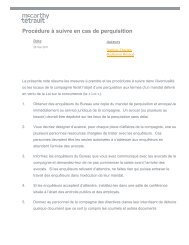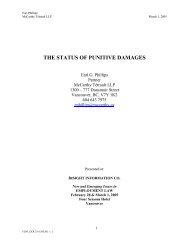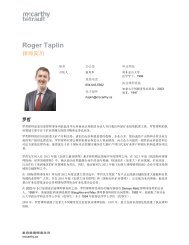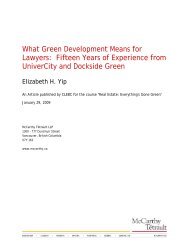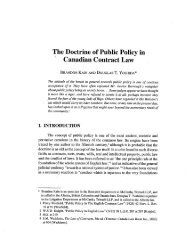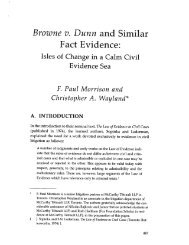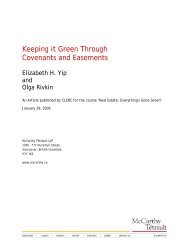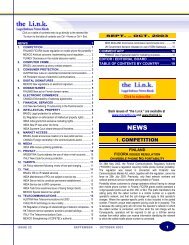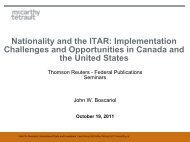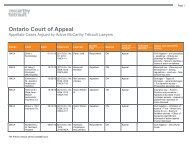Presentation Material - McCarthy Tétrault
Presentation Material - McCarthy Tétrault
Presentation Material - McCarthy Tétrault
You also want an ePaper? Increase the reach of your titles
YUMPU automatically turns print PDFs into web optimized ePapers that Google loves.
Chris Falk<br />
Stefanie Morand<br />
<strong>McCarthy</strong> Tétrault LLP<br />
• Recent commentary suggests that in appropriate cases it may be helpful to complete the<br />
transactions within the estate’s first taxation year so that subsection 164(6) capital loss<br />
carry-back planning may be available as a “fallback” option. 56<br />
SUBSECTION 164(6) CAPITAL LOSS CARRY-BACK PLANNING<br />
Background<br />
As discussed above, subsection 164(6) capital loss carry-back planning is another technique<br />
employed by tax practitioners to relieve against the double taxation that can arise under the Act<br />
as a result of the deemed disposition on death.<br />
Subsection 164(6) is an exceptional provision in that it allows, in some circumstances, a capital<br />
loss sustained by the estate to be carried back to the deceased’s terminal return and applied<br />
against the capital gain that arose as a consequence of the deemed disposition on death. The<br />
provision requires that the loss be sustained in the estate’s first taxation year, 57 and is subject to<br />
numerous stop-loss rules.<br />
In a 2006 Tax for the Owner-Manager article, 58 Nick Moraitis and Manu Kakkar discussed a<br />
potential circularity problem with estate loss carry-backs owing to the drafting of subsections<br />
40(3.6), 40(3.61) and 164(6). This summer at the 2012 STEP Round Table, the CRA was<br />
asked to comment on the interaction of these provisions and, in so doing, expressed a view that<br />
could render subsection 164(6) capital loss carry-back planning unavailable for many estates.<br />
The authors comment below on the issue raised at the 2012 STEP Round Table and the CRA’s<br />
response. In summary, it is the authors’ view that:<br />
• given the text, context and purpose of subsections 40(3.6), 40(3.61) and 164(6), the<br />
provisions should be interpreted in a manner which does not give rise to the circularity<br />
issue identified in the Moraitis/Kakkar Article and addressed in the CRA’s recent<br />
response;<br />
• if, however, contrary to what in the authors’ view is the better interpretation, the<br />
provisions are to be interpreted so as to give rise to the circularity issue due to a<br />
technical flaw in the drafting of subsection 40(3.61), a legislative fix is required so as not<br />
to frustrate the underlying purpose and policy of the provisions; and<br />
55<br />
56<br />
57<br />
58<br />
Paragraph 88(1)(d.1). In this case, the issue should then focus on GAAR; whether there has been a misuse or<br />
abuse for purposes of section 245 notwithstanding: (i) the deemed disposition on death; (ii) the provisions of<br />
section 84.1; and (iii) that the estate should not normally be regarded as an “accommodation party” in facilitating<br />
a surplus strip.<br />
Stuart Bellefer, “Summary of the CRA Round Table Held at the 13th National STEP Canada Conference”<br />
(August 2011) 199 CCH Estate Planner Newsletter, 4-6 (which notes that it would generally be necessary to latefile<br />
the subsection 164(6) designation, which would require that a fairness request be brought by the taxpayer<br />
pursuant to subsection 220(3.2) and Income Tax Regulation 600(b)).<br />
The provision does not refer to the first calendar year following the death of the deceased. Planners should be<br />
careful not to inadvertently trigger an early taxation year by, for example, running afoul of the “anti-stuffing” rules<br />
in the proposed amendments to the definition of “testamentary trust” in subsection 108(1).<br />
Nick Moraitis and Manu Kakkar, “Potential Circularity Problem with Estate Loss Carryback”, (July 2006) 6:3 Tax<br />
for the Owner-Manager (ctf.ca) (the “Moraits/Kakkar Article”).<br />
560600/422632<br />
MT DOCS 11864055v1G<br />
19



